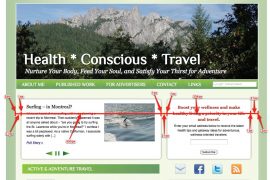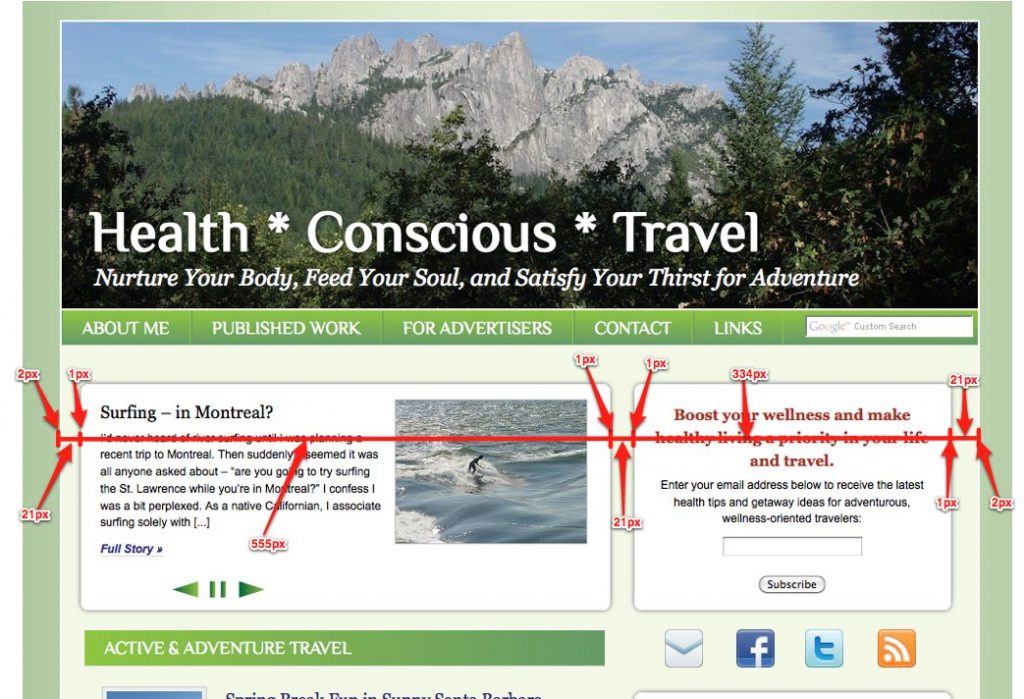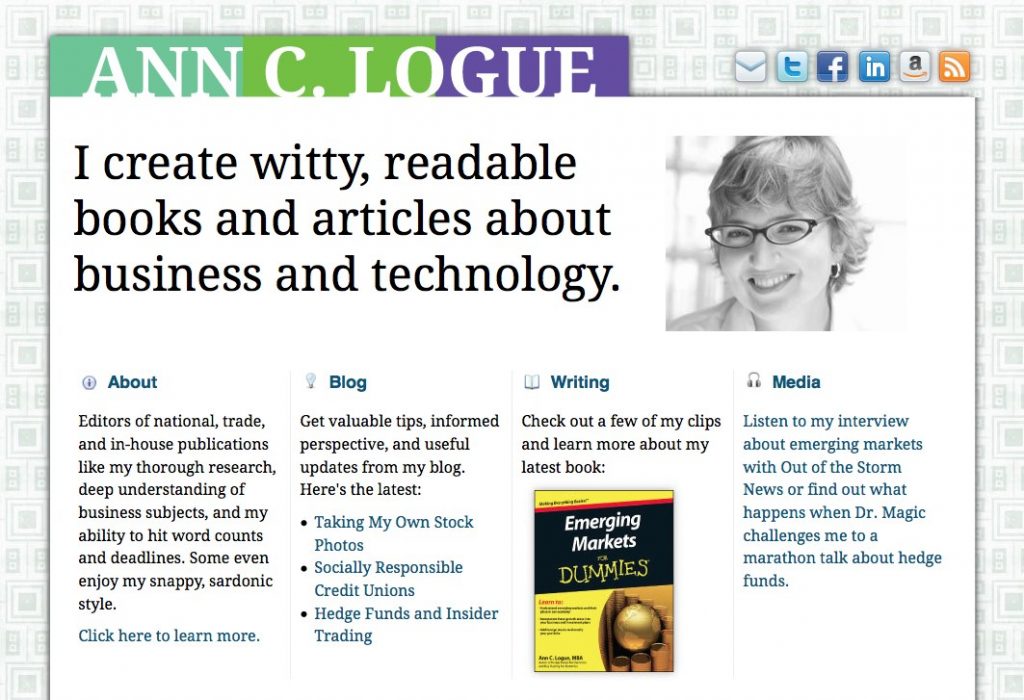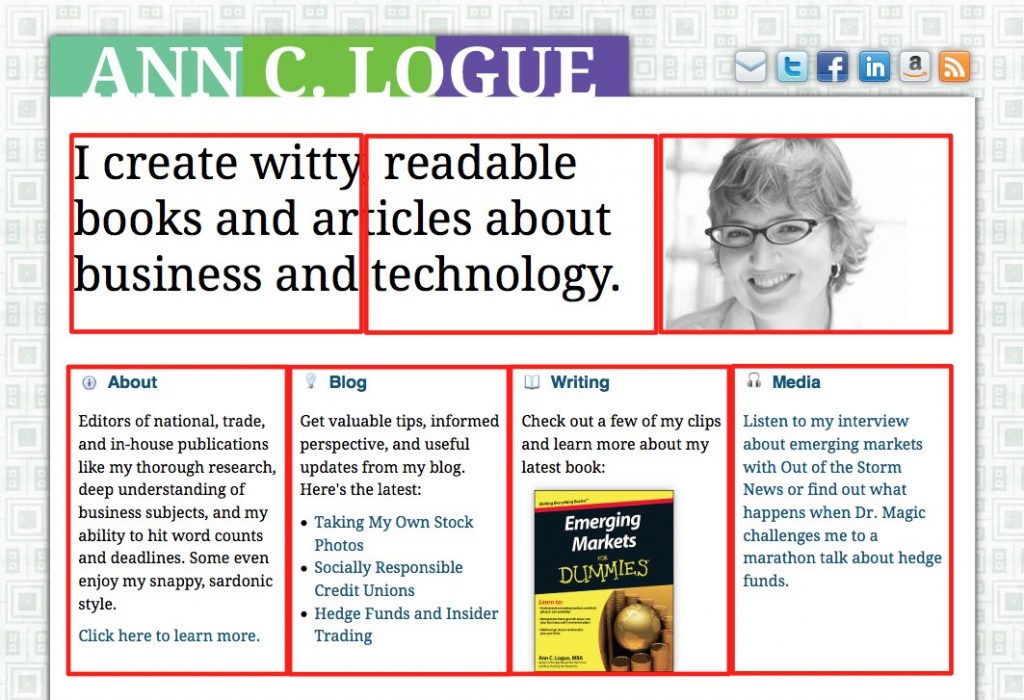Ron S. Doyle is both a web designer and a freelance writer. In fact, he’s found a particular niche in developing web sites for other freelance writers. He’s also got a wicked sense of humor and uses math in his work.
Can you explain what you do for a living?
The highfaluting answer: I help clients build or restructure their online presence through web development and design, business analysis, project management, strategic brand management, consultation and training.
The mundane answer: I make websites!
When do you use basic math in your job?
I use proportions, algebra and basic geometric concepts at work every day. Most of what I’m doing involves simple addition, counting pixels. For example, if a website’s main container is 960 pixels wide, I have to make sure that all the margins, padding, borders and boxes inside add up.
The Health*Conscious*Travel homepage above is 960 pixels wide, but here’s what I see:
2px border + 21px padding + 1px border + 555px feature box + 1px border + 21px padding + 1px border +
334px subscribe box +1px border + 21px padding + 2px border = 960 pixels wide!
This basic addition turns into algebra when a client comes to me and says “I have this 300 pixel wide advertisement that must go here” or
“I want to embed this YouTube video there.” Then all the other elements become variables—and I change them to make everything balance with the ad or video.
It gets even more complicated when I start adding things like drop shadows or glowing edges to an object, which have a specific radius from the edge. A 3px drop shadow spreads 1.5 px past the edge of the object, etc.
Certain objects, like videos, also must appear in specific proportions, e.g., 16:9. For example, if I know I must fit a high-definition video into a space that’s 500 pixels wide, I know that the video will be a little more than 281 pixels tall.
16/9 = 500/x
16x = 4,500
x = 281.25
I also use proportions for my favorite design element: The Golden Ratio, 1: 1.618. It’s a proportion that naturally occurs in nature and is used widely in design and architecture. I agree with the ancient Greeks that it’s a beautiful shape and I try, whenever possible, to use it in my designs. Sometimes, it’s a fun little secret for me. For example, Ann Logue’s website doesn’t seem to have many boxes or rectangles at all:
But there are actually seven golden rectangles coded into the layout:
Do you use any technology (like calculators or computers) to help with this math? Why or why not?
I use paper to draw initial designs, a calculator to figure out proportions and design software like Adobe Creative Suite to help with measurements and placement of objects before I write any code. I suppose I could do it all while I’m writing the code, but I like to keep costs low for my clients—and I like going outside from time to time.
How do you think math helps you do your job better?
Math doesn’t just help me do my job better, it makes it possible.
How comfortable with math do you feel?
None of this math feels uncomfortable to me. All web designers use math, whether they realize it or not, but some have a natural ability to see things like the golden proportion without picking up a calculator. I don’t know if I have that innate aesthetic skill—so the numbers make me feel more confident in my design decisions.
What kind of math did you take in high school? Did you like it/feel like you were good at it?
I didn’t develop a relationship with math until the seventh grade. That year, I had a great algebra teacher; things just clicked and I’ve loved mathematics ever since. I took Geometry, Algebra II, Trigonometry, PreCalculus and AP Calculus in high school. I always felt confident in math class, except Calculus; my teacher struggled teaching the subject and I had a bad case of graduation fever.
As a psychology major in college, I didn’t love research but I enjoyed the statistical part of the work (and I took Calculus for Engineers even though it wasn’t required). Before I started my current business, I was a high school teacher. Trigonometry was one of my favorite subjects to teach.
Did you have to learn new skills in order to do this math? Or was it something that you could pick up using the skills you learned in school?
School definitely helped me feel confident with math, but I learned the skills I use today from building things with my father when I was younger. I spent a lot of my childhood with a tape measure with my father rattling off fractions at me—I understood 5/8 and 3/4 and 9/16 on a visual level long before I learned them in school.
Everything else I learned from Donald Duck in Mathemagic Land:
Do you have questions for Ron? If so, ask them in the comments section below.




